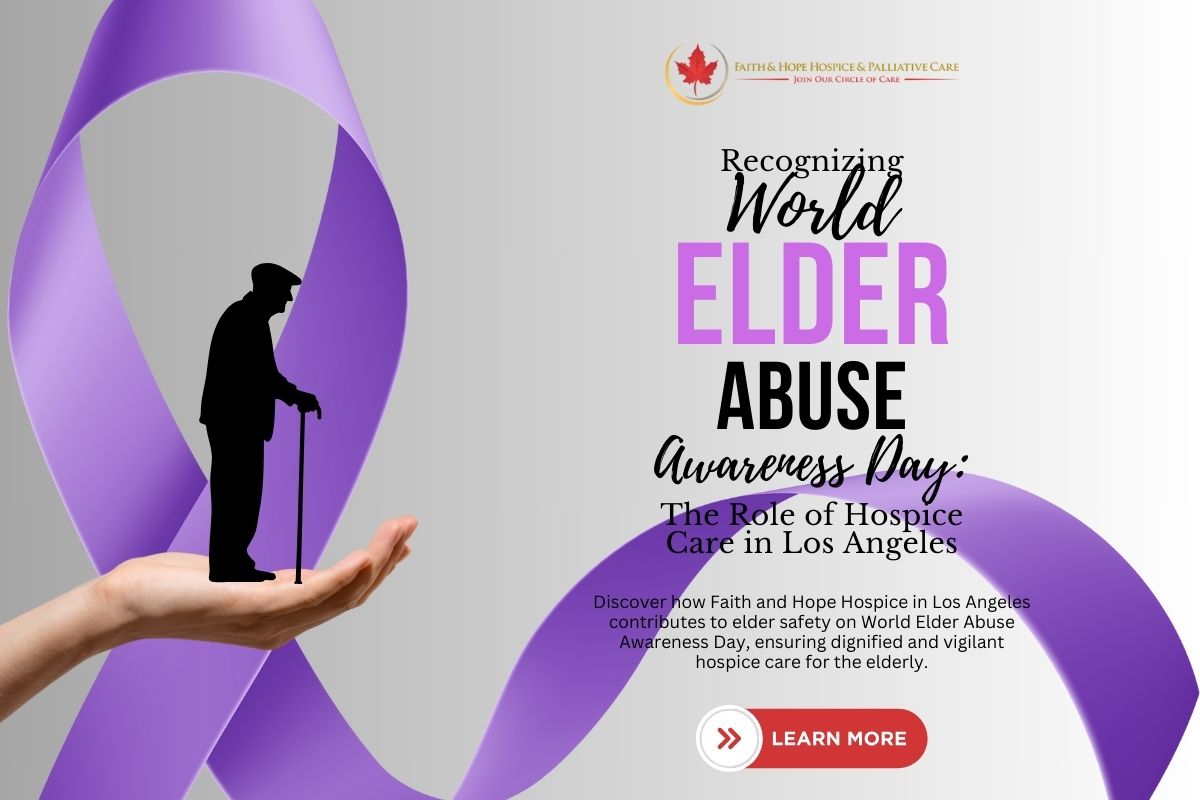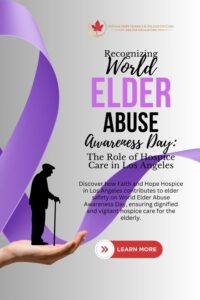
June 15, 2024, marks World Elder Abuse Awareness Day, an essential observance to highlight the ongoing issue of elder abuse and the critical need to protect vulnerable elderly populations. In Los Angeles, organizations like Faith and Hope Hospice are at the forefront of providing safe and respectful environments for seniors, especially those receiving hospice care. As we observe this day, it’s vital to discuss how hospice care in Los Angeles plays a pivotal role in safeguarding the dignity and well-being of our elderly.
Elder abuse encompasses a range of harmful behaviors, including physical, emotional, and financial abuse, as well as neglect and exploitation. Sadly, this issue affects millions of older adults around the world, often leading to severe physical injuries and emotional scars. The elderly in need of hospice care are particularly vulnerable due to their increased dependence on caregivers.

Faith and Hope Hospice in Los Angeles exemplifies the role of hospice care in combating elder abuse by ensuring that seniors receive compassionate, respectful, and dignified care. Hospice care providers are uniquely positioned to observe and report any signs of abuse, making them critical in the effort to protect the elderly.
Hospice teams, including those at Faith and Hope Hospice, are trained to recognize the signs of elder abuse, which is crucial for early detection and intervention. Their continuous and close monitoring ensures that any unusual signs are noticed and addressed promptly. This vigilance helps create a protective barrier around the patient, safeguarding them from potential harm.
A significant aspect of hospice care in Los Angeles, particularly with Faith and Hope Hospice, involves educating caregivers and families about the risks of elder abuse. This education includes training on how to respect the autonomy and dignity of seniors, even as they become more physically and emotionally vulnerable. By fostering a deeper understanding of the ethical and compassionate treatment of the elderly, hospice care workers play an essential role in prevention.
Faith and Hope Hospice not only provides direct care but also acts as an advocate for the elderly. This includes working with legal and social services to protect patients’ rights and ensure their well-being. Hospice care providers often serve as the voice for those who may no longer be able to speak for themselves, advocating for their needs and rights in various settings.
The ethos of hospice care, especially in providers like Faith and Hope Hospice in Los Angeles, is fundamentally about compassion and dignity. The approach is tailored to ensure that the emotional, physical, and spiritual needs of the elderly are met in a manner that respects their value and contributions to society.
As we recognize World Elder Abuse Awareness Day, it’s crucial to highlight the protective role of hospice care in Los Angeles. Facilities like Faith and Hope Hospice are not just providing end-of-life care but are vital in ensuring a safe, respectful, and caring environment for our seniors. Their dedicated efforts in elder protection show a commitment not only to quality hospice care but to the broader values of dignity and respect for all individuals, regardless of age.
Faith and Hope Hospice
We firmly believe that the internet should be available and accessible to anyone, and are committed to providing a website that is accessible to the widest possible audience, regardless of circumstance and ability.
To fulfill this, we aim to adhere as strictly as possible to the World Wide Web Consortium’s (W3C) Web Content Accessibility Guidelines 2.1 (WCAG 2.1) at the AA level. These guidelines explain how to make web content accessible to people with a wide array of disabilities. Complying with those guidelines helps us ensure that the website is accessible to all people: blind people, people with motor impairments, visual impairment, cognitive disabilities, and more.
This website utilizes various technologies that are meant to make it as accessible as possible at all times. We utilize an accessibility interface that allows persons with specific disabilities to adjust the website’s UI (user interface) and design it to their personal needs.
Additionally, the website utilizes an AI-based application that runs in the background and optimizes its accessibility level constantly. This application remediates the website’s HTML, adapts Its functionality and behavior for screen-readers used by the blind users, and for keyboard functions used by individuals with motor impairments.
If you’ve found a malfunction or have ideas for improvement, we’ll be happy to hear from you. You can reach out to the website’s operators by using the following email
Our website implements the ARIA attributes (Accessible Rich Internet Applications) technique, alongside various different behavioral changes, to ensure blind users visiting with screen-readers are able to read, comprehend, and enjoy the website’s functions. As soon as a user with a screen-reader enters your site, they immediately receive a prompt to enter the Screen-Reader Profile so they can browse and operate your site effectively. Here’s how our website covers some of the most important screen-reader requirements, alongside console screenshots of code examples:
Screen-reader optimization: we run a background process that learns the website’s components from top to bottom, to ensure ongoing compliance even when updating the website. In this process, we provide screen-readers with meaningful data using the ARIA set of attributes. For example, we provide accurate form labels; descriptions for actionable icons (social media icons, search icons, cart icons, etc.); validation guidance for form inputs; element roles such as buttons, menus, modal dialogues (popups), and others. Additionally, the background process scans all the website’s images and provides an accurate and meaningful image-object-recognition-based description as an ALT (alternate text) tag for images that are not described. It will also extract texts that are embedded within the image, using an OCR (optical character recognition) technology. To turn on screen-reader adjustments at any time, users need only to press the Alt+1 keyboard combination. Screen-reader users also get automatic announcements to turn the Screen-reader mode on as soon as they enter the website.
These adjustments are compatible with all popular screen readers, including JAWS and NVDA.
Keyboard navigation optimization: The background process also adjusts the website’s HTML, and adds various behaviors using JavaScript code to make the website operable by the keyboard. This includes the ability to navigate the website using the Tab and Shift+Tab keys, operate dropdowns with the arrow keys, close them with Esc, trigger buttons and links using the Enter key, navigate between radio and checkbox elements using the arrow keys, and fill them in with the Spacebar or Enter key.Additionally, keyboard users will find quick-navigation and content-skip menus, available at any time by clicking Alt+1, or as the first elements of the site while navigating with the keyboard. The background process also handles triggered popups by moving the keyboard focus towards them as soon as they appear, and not allow the focus drift outside it.
Users can also use shortcuts such as “M” (menus), “H” (headings), “F” (forms), “B” (buttons), and “G” (graphics) to jump to specific elements.
We aim to support the widest array of browsers and assistive technologies as possible, so our users can choose the best fitting tools for them, with as few limitations as possible. Therefore, we have worked very hard to be able to support all major systems that comprise over 95% of the user market share including Google Chrome, Mozilla Firefox, Apple Safari, Opera and Microsoft Edge, JAWS and NVDA (screen readers).
Despite our very best efforts to allow anybody to adjust the website to their needs. There may still be pages or sections that are not fully accessible, are in the process of becoming accessible, or are lacking an adequate technological solution to make them accessible. Still, we are continually improving our accessibility, adding, updating and improving its options and features, and developing and adopting new technologies. All this is meant to reach the optimal level of accessibility, following technological advancements. For any assistance, please reach out to
